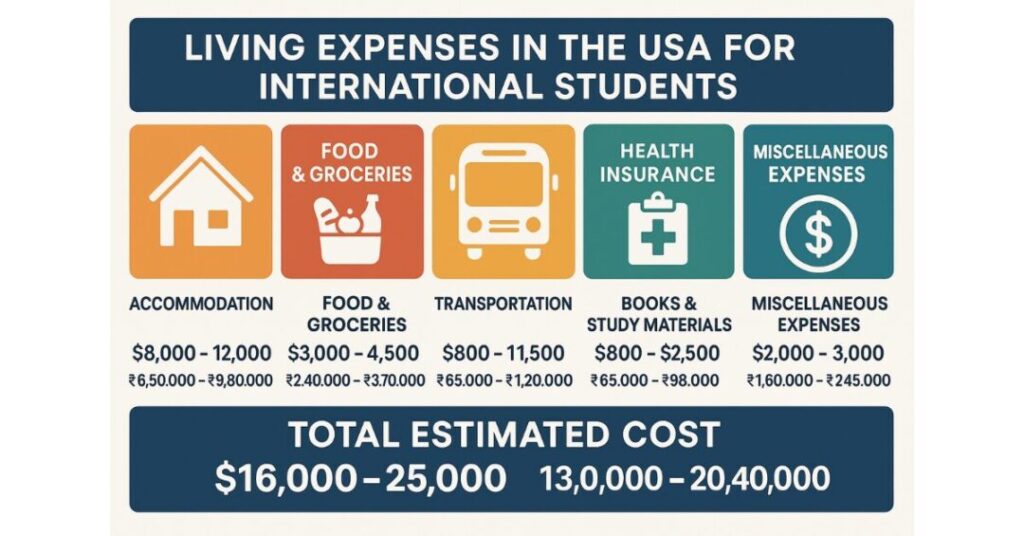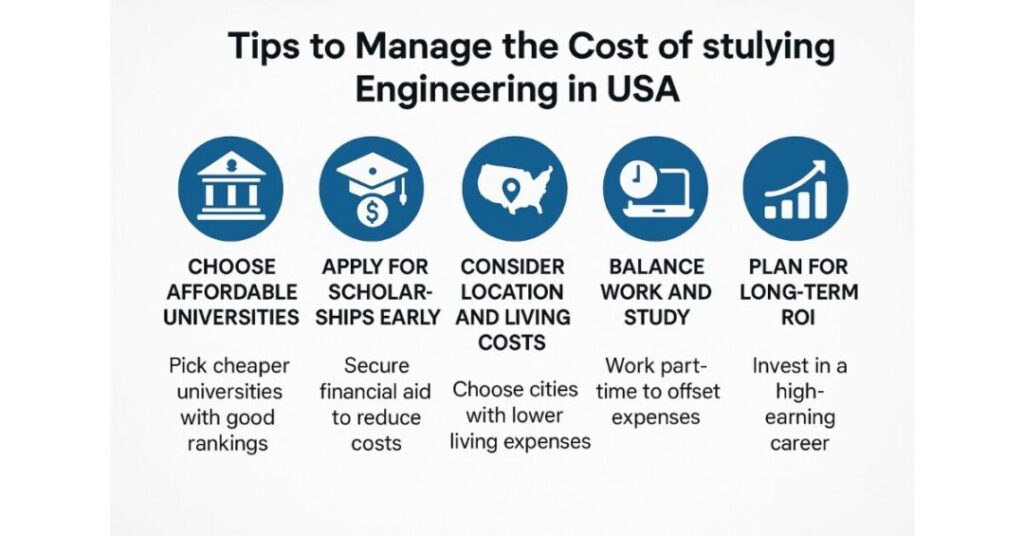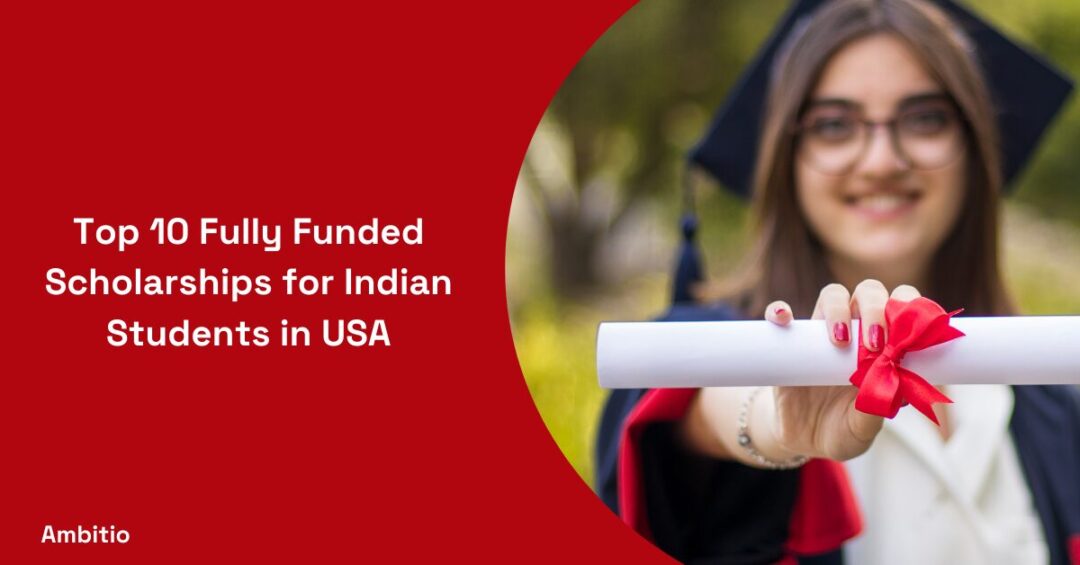16 September 2025
6 minutes read
Cost of Studying Engineering in USA for Indian Students

Key Takeaways
- Cost of studying engineering in USA can cross ₹40–55 lakhs a year, but scholarships and assistantships help reduce the total burden.
- Public vs private universities, location, and field choice play a big role in balancing affordability with long-term career returns.
- Smart planning with aid, part-time work, and budgeting makes studying in the US a rewarding investment for Indian students.
Did you know that for the cost of studying engineering in USA for Indian students can go well above ₹40–50 lakhs with tuition fee, application fee, accommodation, and cost of living? For many, the dream of studying engineering at top university in the US is very quickly out of the window.
Students can apply for scholarships, plan their expenses, and manage to study in the US without breaking the bank. This guide puts together realistic costs and practical solutions so you know exactly what you are looking at before you go.
Why Indian Students Choose USA for Engineering Studies?
Indian students often choose to study engineering in the USA because it offers world-class education, access to top universities, and unmatched career opportunities. Despite the high cost of studying engineering in USA, including tuition fee, living cost, and student visa expenses, the return on investment is substantial.
With diverse engineering courses like mechanical, civil, electrical, and software engineering, US universities and colleges provide global exposure, cutting-edge research, and lucrative job prospects, making it a smart study abroad choice.
Average Cost of Studying Engineering in USA for Indian Students
The cost of studying engineering in USA for Indian students depends on the university, specialization, and city. While the tuition fee is the biggest component, factors like cost of living in USA, student visa cost, and post-arrival expenses also add to the overall cost.
On average, engineering in USA for international students ranges between ₹30–55 lakhs annually, but many universities offer scholarships to international students that can reduce the total cost. Here’s a breakdown of the average annual tuition fees at top universities in the USA (converted to INR):
| University (QS World Rankings 2024) | Popular Engineering Specializations | Average Annual Tuition Fee (USD) | Average Annual Tuition Fee (INR) |
|---|---|---|---|
| Massachusetts Institute of Technology (MIT) | Mechanical, Civil, Electrical, Software Engineering | $55,000 | ₹45,00,000 |
| Stanford University | Computer Science, Electrical, Civil Engineering | $54,000 | ₹44,30,000 |
| University of California, Berkeley | BTech, Mechanical, Civil, Electrical | $45,000 | ₹36,90,000 |
| Carnegie Mellon University | Software Engineering, Robotics, Electrical | $52,000 | ₹42,70,000 |
| University of Michigan, Ann Arbor | Mechanical, Civil, Electrical Engineering | $48,000 | ₹39,40,000 |
| Georgia Institute of Technology | Civil, Mechanical, Aerospace Engineering | $31,000 | ₹25,50,000 |
| Purdue University | Mechanical, Civil, Electrical, Software | $29,000 | ₹23,80,000 |
| Texas A&M University | Civil, Petroleum, Electrical Engineering | $27,000 | ₹22,20,000 |
Living Expenses in the USA for International Students
When calculating the cost of studying engineering in USA, Indian students must consider more than tuition fees. Living in the USA adds a significant portion to the overall cost to study, including accommodation, food, healthcare, and transportation.

For those who wish to study an engineering course in the USA, these everyday expenses can affect the overall cost almost as much as tuition. Here’s a breakdown of the average annual living expenses for international students at a college in the USA:
| Expense Category | Average Annual Cost (USD) | Average Annual Cost (INR) | Notes |
|---|---|---|---|
| Accommodation (On/Off-Campus) | $8,000 – $12,000 | ₹6,50,000 – ₹9,80,000 | Varies by city and housing type |
| Food & Groceries | $3,000 – $4,500 | ₹2,40,000 – ₹3,70,000 | Eating out vs home cooking |
| Transportation | $800 – $1,500 | ₹65,000 – ₹1,20,000 | Public transit or owning a car |
| Health Insurance | $1,500 – $2,500 | ₹1,20,000 – ₹2,00,000 | Mandatory for international students |
| Books & Study Materials | $800 – $1,200 | ₹65,000 – ₹98,000 | Depends on course in the USA |
| Miscellaneous Expenses | $2,000 – $3,000 | ₹1,60,000 – ₹2,45,000 | Personal, leisure, clothing, etc. |
| Total Estimated Cost | $16,000 – $25,000 | ₹13,00,000 – ₹20,40,000 | Adds to tuition fees in USA |
Scholarships and Financial Aid for Indian Students
Managing the cost of studying engineering in USA can feel overwhelming for Indian students, but numerous scholarships and financial aid options help cover tuition fees, living costs, and even post-arrival cost.
Many US universities offer merit-based, need-based, or specialization-focused awards that make it easier to pursue engineering at top-ranked schools. Here’s a list of popular scholarships for Indian students who wish to study in the USA and reduce the total cost to study in USA:
| Scholarship / Aid Program | Offered By | Coverage | Eligibility |
|---|---|---|---|
| Fulbright-Nehru Master’s Fellowships | USIEF (Govt. of USA & India) | Tuition fees, living expenses, study visa, airfare | Indian graduates applying for master’s/engineering degree |
| Inlaks Shivdasani Scholarships | Inlaks Foundation | Covers tuition and living in the USA up to $100,000 | High academic record, admission to top universities in the USA |
| Tata Scholarship for Cornell University | Tata Education Trust | Covers full tuition fees in USA | Indian students admitted to Cornell (engineering as well) |
| Stanford Reliance Dhirubhai Fellowship | Stanford University | Covers 80% of tuition for MBA/Engineering-related studies | Indian students with financial need |
| AAUW International Fellowships | American Association of University Women | $20,000–$50,000 | Female students at US universities in the field of engineering and sciences |
| University-Specific Assistantships | US Universities & Colleges | Tuition fee waivers + stipends | Engineering graduates working as Teaching/Research Assistants |
Cost Comparison: Public vs Private Universities in USA
Here’s a comparison of public vs private universities in the USA, especially for those considering the cost of studying engineering in USA as Indian students. Includes tuition, fees, and key trade-offs you should know.
| Type of University | Typical Annual Tuition & Fees (USD) | What’s Included / Excluded | Pros for Indian Students | Cons / Key Considerations |
|---|---|---|---|---|
| Public University (Out-of-State Fees) | ~$25,000-$35,000 per year | Covers tuition, basic fees; excludes room, board, travel, student visa application, post-arrival cost etc. | Lower cost than private; strong in mechanical engineering, electrical engineering; many public engineering schools have strong research & job opportunities. | As an international student you pay out-of-state rates anyway; fewer big merit scholarships; sometimes less prestige or smaller alum networks than elite privates. |
| Private University (Non-Profit) | ~$45,000-$55,000+ per year | Tuition + fees; still extra for accommodation, living in the USA, visa, health insurance etc. | Often more scholarship/aid opportunities; higher QS rankings; better labs, facilities; may give more support for students pursuing engineering degree. | Much higher cost to study; overall cost increases sharply after adding living cost, post-arrival expenses, visa application etc.; more competition; higher expectations. |
Return on Investment: Is the Cost Worth It for Indian Students?
The cost of studying engineering in USA may seem overwhelming at first, but for many Indian students, it often proves to be a long-term investment rather than just an expense. With access to advanced research, global exposure, and practical learning, the value of a degree in engineering from the USA is unmatched.
Since engineering is one of the most in-demand fields worldwide, graduates from US universities secure high-paying roles across industries. For students weighing costs against outcomes, the return often justifies the investment.
Tips to Manage the Cost of Studying Engineering in USA
Managing the cost of studying engineering in USA can feel challenging for Indian students, but with the right approach, it becomes more manageable.

Since a degree in engineering opens doors to global careers, planning finances smartly ensures the journey is smooth and rewarding.
- Choose Affordable Universities
Not every option is expensive; students prefer the cheapest universities in USA that still rank well in the QS World University Rankings. Picking wisely can reduce tuition fees for undergraduate courses without compromising quality. - Apply for Scholarships Early
Many USA universities provide aid to international students. Securing scholarships can significantly cut down tuition and living costs in USA, making studying abroad more accessible. - Consider Location and Living Costs
Living expenses vary since engineering in the USA varies by city. Smaller towns often offer lower rent and food costs, helping reduce the overall financial burden compared to top engineering hubs. - Balance Work and Study
While pursuing a bachelor’s degree, students can work part-time on campus. This not only offsets costs in USA but also builds experience relevant to future engineering career opportunities. - Plan for Long-Term ROI
Though upfront expenses are high, remember that engineering is one of the most lucrative professions in the US. Graduates of engineering colleges often recover their investment within a few years, making it a smart move for those who wish to apply for a student visa and build global careers.
Conclusion
While the cost of studying engineering in USA may appear daunting, the long-term rewards make it a powerful investment for Indian students. From world-class exposure to high-paying careers, a degree in engineering from US universities is truly transformative. But success depends on more than just finances; it starts with building a strong profile that gets you into the right schools.
At Ambitio, we don’t just guide you, we help you stand out. From profile building to personalized admission strategies, we make your US study dream achievable. Ready to shape your future? Start your journey with Ambitio Elite today!
FAQs
What is the average annual cost, including tuition and living expenses, for studying engineering in the USA?
The average annual cost, including tuition and living expenses, can range significantly based on the university and city. It’s essential to research specific programs and locations for accurate estimates.
Can international students work while studying in the USA to offset costs?
Yes, international students on F-1 visas are allowed to work part-time on-campus and potentially off-campus with specific authorizations, which can help offset living costs.
How important is it to consider the cost of living in addition to tuition fees?
The cost of living can sometimes equal or surpass tuition fees, especially in major cities. It’s crucial to consider both these aspects for a realistic financial plan.
Are there any hidden costs that international students should be aware of?
Yes, students should be aware of hidden costs like health insurance, personal expenses, travel, and cultural adaptation costs, which can add to the overall budget.
How can students apply for scholarships in the USA?
Students can apply for scholarships through university financial aid offices, external organizations, and foundations. Researching and applying early is key to securing these funds.

You can study at top universities worldwide!
Get expert tips and tricks to get into top universities with a free expert session.
Book Your Free 30-Minute Session Now! Book a call now




























